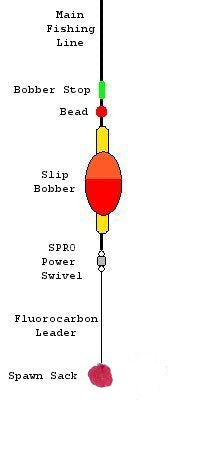
For floating spawn sacks most fishermen use a spinning rod or noodle rod with a length of 8ft, 9ft, or even 10 ft. The 10 foot noodle rod is the most popular. The ten foot length of the noodle rod allows the fishermen to cast long distances with light presentations, allows the most line pickup on a hook set, and gives the fishermen more leverage against the fish during the fight. Attached to the spinning rod is usually a standard sized spinning reel that must have a good drag and hold about 250-300 yards of 8-12 pound test line. I prefer to use either a reel with a "fighting Drag" or a "Bait Runner" type reel. Either of these types of reels will allow line to feed freely when a steelhead hits the spawn. Most fishermen a few years ago, switched from using monofilament line to one of the super braided lines like Berkley Fireline or Power Pro. The size of line varies from 6-10 pound test Berkley Fireline with 8 pound test being the most popular. The non-stretch properties and thin diameters allow longer casts and gives great hook setting ability at long distances. Remember that because there is virtually no line stretch with Fireline to set your reels drag lighter than normal, to allow the fish to run.







